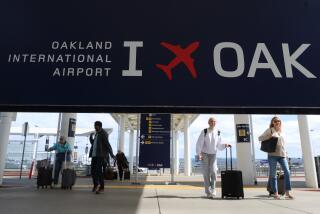Airlines Fight for Space at Long Beach Airport
Just last spring, Long Beach officials were begging airlines to provide service at the city’s 79-year-old airport. No more. Today, several carriers are fighting to fill their jets from the airport’s Art Deco-style terminal.
Since low-cost carrier JetBlue Airways opened its West Coast hub last summer at the tiny airport alongside the San Diego Freeway, passenger traffic has climbed 41%. JetBlue expects to increase its flights at Long Beach from three to 27 a day in the next year.
Now, other airlines want access to the “slots” that the upstart carrier isn’t using.
And the tiny airport finds itself with too many suitors--saying that it may be able to offer only temporary takeoff and departure times to other airlines. That is not good enough for at least one carrier, American Airlines, which has threatened to sue.
Space at Long Beach Airport is scarce because of a 1995 federal lawsuit settlement that limited the number of commercial takeoffs at the airport to 41 per day. That was in response to local efforts to reduce noise.
All 41 of these slots are now reserved by airlines. Some are in use; others are being held for flights that are supposed to be added later.
American Airlines would like to add four more flights daily, to Chicago and New York, on top of the four it offers to Dallas.
And, after a seven-year absence from Long Beach, Alaska Airlines announced Monday that it will request three slots, for flights to Seattle.
American has upped the ante in the debate by selling tickets for the additional Long Beach flights, even before airport officials agree to make room for the extra planes.
Airline representatives said federal law requires airport officials to accommodate their requests to add service at the facility--wedged between overcrowded Los Angeles International Airport to the north and John Wayne Airport to the south, which also operates under flight restrictions.
“The fact of the matter is that only 17 of their 41 jet slots are in use,” said Al Becker, an American spokesman. “We have no desire to enter into litigation with the city of Long Beach, and our sincere hope and wish is that we can resolve this issue amicably. All we want to do is operate our service and be able to compete.”
As part of the 1995 settlement, the airlines and the city were prohibited from suing each other for six years. The litigation truce period ended Jan. 1.
The Long Beach City Council, which operates the airport, is scheduled to discuss the matter today in closed session.
American said it began selling tickets on the proposed flights from Long Beach to New York and Chicago because it will have at least temporary slots at the city-run facility when the service begins June 15.
Airport administrators said they offered American the use of temporary slots when the airline filed its initial request for service in February. But the company turned the airport down, said Sharon Diggs-Jackson, the facility’s public affairs officer. The airport also asked airlines that use its facility if they would relinquish some of their slots to American. The competitors refused.
Instead, American has been offered a temporary solution: Use slots promised to other airlines that are yet to expand their own schedules. But most of those spots probably will disappear by next spring, when the other carriers add their flights, Diggs-Jackson said.
American said it is determined to have the airport dedicate four more permanent slots for its planes.
Industry watchers said the attempts by more established carriers to compete with JetBlue at Long Beach have historical precedent: Bigger airlines traditionally have challenged smaller carriers when they start to gain a foothold on lucrative routes.
“A year ago if you went to American and said, ‘Hey guys, how about coming to Long Beach?’ their answer would have been, ‘Why?’” said Ed Faberman, executive director of the Air Carrier Assn., an advocacy group for smaller airlines. “All of the sudden there is a carrier offering competition and choice and they don’t want that competition.”
The New York-based JetBlue offers three daily nonstop flights from Long Beach to New York’s John F. Kennedy International Airport. The company plans to add another flight to New York in June and two flights to Washington, D.C., in May.
The upstart sets itself apart by offering leather seats and TV screens, with 24 channels, in every seat back. It also offers low fares on its fleet of new blue and white Airbus A320s and aggressively markets its service, even going so far last summer as to hand out bumper stickers that read “Goodbye, LAX” at beaches.
JetBlue agreed to come to Long Beach last spring after months of secret negotiations with Long Beach officials, who desperately wanted a low-fare airline at the underused airport. The airline pays $120,000 every 90 days to hold the 24 time slots that it has not yet filled with flights.
David Neeleman, JetBlue’s chief executive, said in a statement Monday that the carrier “is on schedule to utilize the 27 air carrier slots it was allocated by next spring,” but declined to respond directly to the other airlines’ actions.
Other carriers denied that their interest in Long Beach stems from JetBlue’s success, or that they are trying to block the airline’s expansion bid.
American wants more flights to New York because it is expanding its overall service from JFK, where the carrier is building a $1.3-billion terminal, Becker said.
As for Alaska Airlines, its ability to expand in recent months has been crimped by capacity constraints at other airports, “and we believe there’s growth potential at Long Beach Airport,” said Lou Cancelmi, an Alaska spokesman. He said the carrier is “hopeful that we’re going to get the [time] slots” to start service from Long Beach to Seattle on Sept. 8.
City administrators said they are unsure how American Airlines can confidently advertise additional service from Long Beach to its customers when they do not yet have dedicated time slots.
“The other airlines see that JetBlue is very successful and has a very good load factor and now they want slots,” said Long Beach City Councilwoman Jackie Kell, whose district includes the airport.
“Selling tickets may or may not get them anywhere, because those slots haven’t been given to them,” Kell said. “The consumer can’t be sure they will have a seat.”
More to Read
Inside the business of entertainment
The Wide Shot brings you news, analysis and insights on everything from streaming wars to production — and what it all means for the future.
You may occasionally receive promotional content from the Los Angeles Times.











